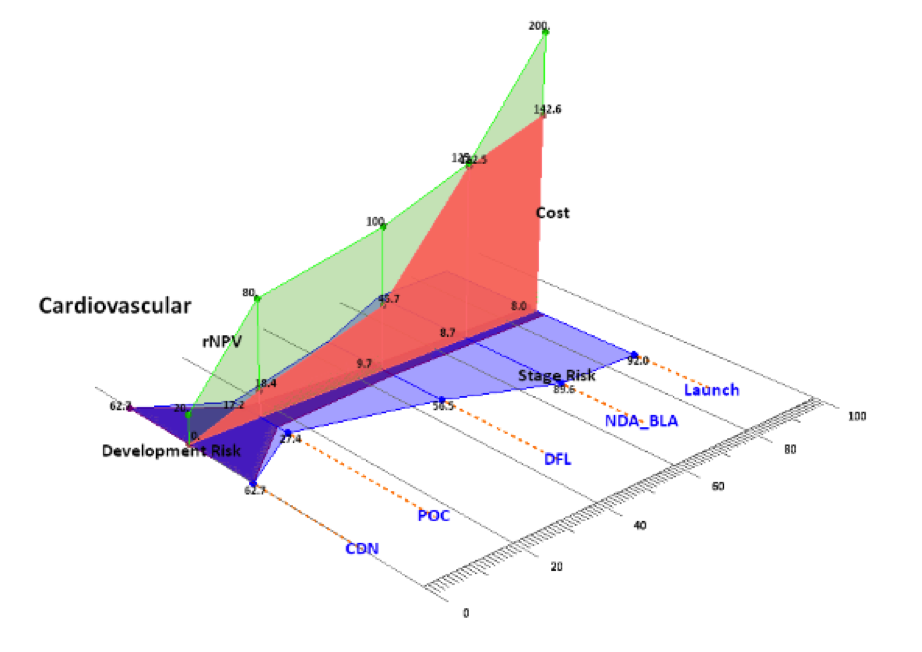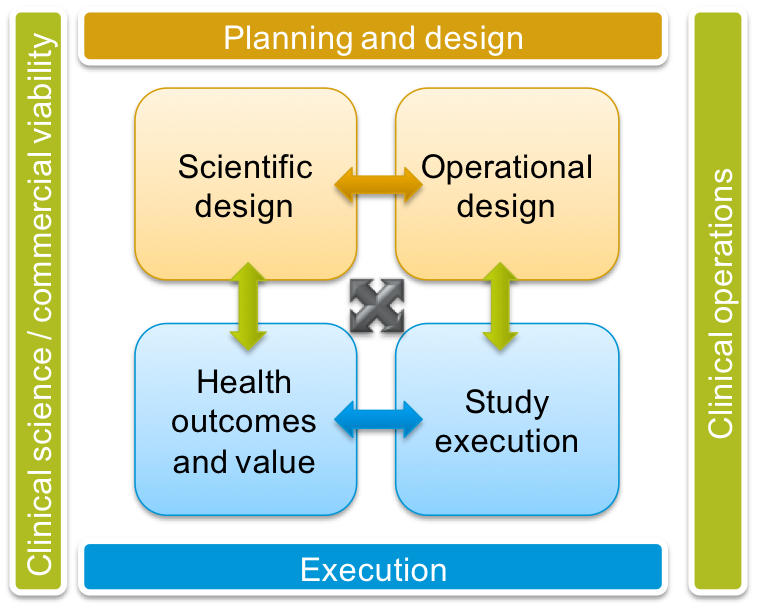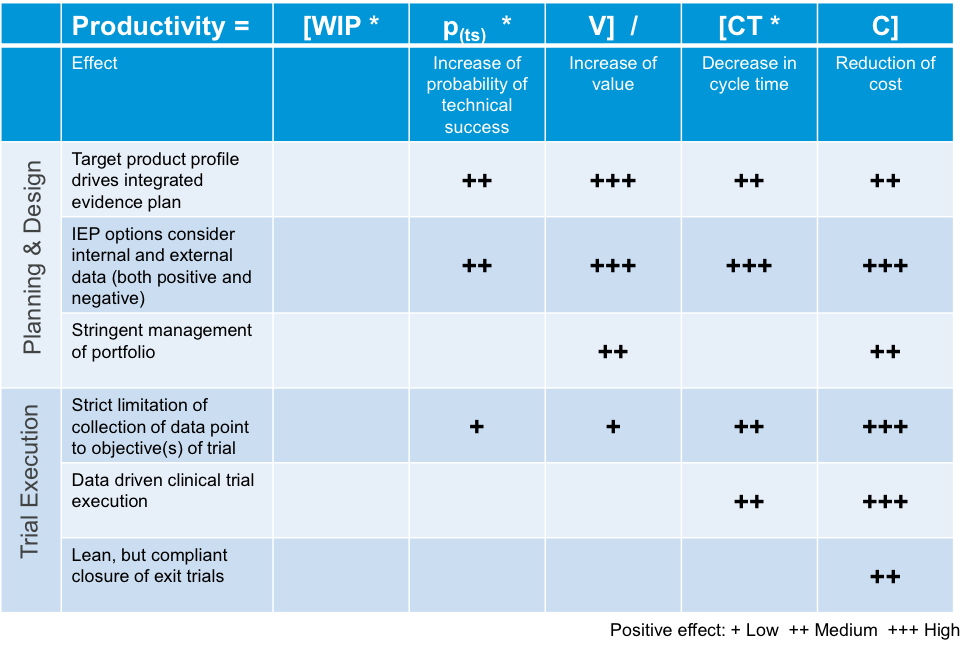How Integrated Value-Based Planning can Lead to a Leap in Development Productivity
Applied Clinical Trials
Integrating evidence-based planning and real-world evidence has the potential to reap big gains for development productivity. Achieving this through a "Three-Pillar" approach emphasizing knowledge sharing, evidence needs, and scenario risk-building is proposed.
Until recently, the number often quoted as the cost of bringing a new drug to market was US $1 billion.1,2 In November 2014, the Tufts Center for the Study of Drug Development reported that developing a new prescription medicine that gains marketing approval, a process often lasting longer than a decade, is estimated to cost $2.558 billion.3 Recent analysis shows that not only have costs risen, but there is high variability among companies in their “costs-per-successful-product” reaching the market.4 Improvements in product selection, product development, and investment decision-making would all improve the likelihood of a product’s successful market entry.
The key issue facing the industry can be described as development productivity. On a portfolio level, this can be defined as a ratio of the current projects in the pipeline (work in progress or WIP), the probability of technical success (p(ts)), and the value of the pipeline (V) divided by the cycle time (CT) and the cost to deliver the pipeline (C).5

This equation conveys the balance of risk, time, and cost (with a factor included for numbers of compounds in a portfolio, though the equation is equally relevant for a single compound [i.e., WIP=1]), weighted against the probability of its technical success and its potential future value; each compound has its own set of dynamics related to the size of the population, market share/competitive landscape, unmet need, differentiation, and market access/pricing considerations.
Biopharmaceutical companies have attempted to address the productivity issue by increasing the number of compounds entering a portfolio (“shots on goal”) and doing whatever they can do to decrease costs and cycle time. However, the productivity equation is dominated by the very low industry-wide “probability of success,” which, in the most recent data, is still only about 15% of new medical products entering human trials.6
Companies have tried to change these odds by targeting patient populations who are most likely to respond to therapy (e.g., through use of biomarkers); the goal is to try to increase the likelihood of positive efficacy results and corresponding positive pricing and reimbursement decisions. Even if a compound meets the regulatory standards that allow for its successful registration, there is no guarantee that the product will be accepted by boards/formularies responsible for pricing and reimbursement, making successful commercialization and patient access challenging. “Effectiveness” has essentially been added as the fourth hurdle to safety, efficacy, and manufacturing quality. Market access strategies continue to be shaped by influential stakeholders.
There are a number of recent examples that speak to this point: England’s National Institute for Health and Care Excellence (NICE) did not recommend GlaxoSmithKline’s belimumab for the treatment of active lupus erythematosus.7 NICE concluded that there was insufficient evidence of improved efficacy versus standard of care and did not recommend use, even though it was the first new approved drug in this indication for decades. In Germany, the law governing pharmaceuticals (AMNOG) was amended in 2011, introducing a formal Health Technology Assessment (HTA). Following this change, Boehringer Ingelheim decided not to launch the new oral anti-diabetic compound linagliptin (Trajenta®). Under the new law, the comparator was not the agreed comparator and the submission was assessed as not adequately justified. 8 9
These examples illustrate that only focusing on development costs and cycle times is not sufficient and needs to be balanced continuously with the potential for a product’s reimbursement and commercial viability to ensure an adequate return on investment for new therapies. This requires forward-looking (and likely, disruptive) thinking at the earliest stages of development. Bringing unmet medical need, differentiation, and value-based thinking into the product development cycle in a way that is easily manifest and transparently addressable for both product development teams and decision-making stakeholders is essential in this approach. Integrating evidence-based planning and real-world evidence (RWE) has the potential to reap even bigger rewards for development productivity, as shown in Figure 1.10 To achieve this, we propose the Three-Pillar approach outlined in this paper.
Figure 1: Value capture from real-world evidence across the lifecycle for a top 10 biopharmaceutical company

Enhance probability of technical success
If biopharmaceutical companies are to realize the next level of transformation and achieve greater development productivity, they need to address the development cycle itself by integrating health outcomes, and using better, evidence-based decision-making approaches. As shown in Figure 2, the net present value of a product is highly dependent on development risk, costs, and cycle time.
Figure 2: The relationship between development risk, cost, cycle time, and net present value
(Click to enlarge)

Net present value (green) is highly dependent on development risk (blue), development costs (red), and development cycle time (shown as time points: CDN – candidate selection; POC – proof of concept; DFL – development for launch - ; BLA/NDA biologics or new drug approval; launch).
Not surprisingly, including commercial viability and market access in the value equation when addressing development risk and cost early provides a far more complete picture for sound development decision-making. To achieve the desired outcome of better development productivity and commercial success, we propose a Three-Pillar approach based on identification of evidence needed for successful market entry and selection of the right plan to generate this evidence. These three pillars are illustrated in Figure 3.
Figure 3: Three-pillar approach linking clinical science and clinical operations underpinned by access to data, information, and knowledge

In Pillar 1, a question-based process identifies what success looks like for the patient, physician, provider, payer, and regulators. A robust target product profile (TPP) is built from the answers to these questions; this will guide creation of an integrated evidence plan that incorporates the clinical and value evidence requirements to support the TPP. Refinement of product needs continues throughout the product life-cycle, including the design of late-stage development and post-marketing programs. This will result in intermittent, but iterative reassessments of the TPP and, correspondingly, the required evidence generation that such a reassessment will necessitate.
Second, an integrated evidence plan (IEP) is designed. The goal is to create a direct line of sight from the TPP to the development strategy and straight through to the trials/studies in the program. The IEP divides required information into two categories: (i) data already available, and (ii) evidence that needs to be generated to advance stakeholder decision-making. The IEP then defines how the evidence will be generated within each clinical trial and real-world observational study, and how this will be leveraged to satisfy patient, physician, provider, payer, and regulatory requirements as defined by the TPP. When value-proving outcomes are investigated early in development, they validate the benefit statements and secure a positive recommendation from HTA and regulatory authorities. The IEP also allows a team to set futility criteria, so that if value evidence is not realized in a timely manner, informed and effective decisions to terminate the program can be made.
In Pillar 3, scenario development and trade-off analysis are used to challenge assumptions both scientifically and operationally and create an evidence-based “level playing field.” This can be done most effectively through facilitated workshops where collective expertise (subject matter experts) and various options for generating needed evidence are reviewed, modified, and critically evaluated. Advanced analytics optimizes the evaluation of complex time/cost/risk/value scenarios in a transparent way to drive the decision-making process for key stakeholders.
Productivity will benefit most when the approach to the pillars is taken in the context of an integrated partnership of the key stakeholders, with early modeling, visualization, and agreement on the “end game.” True end-to-end integration leverages business processes aligned with the three pillars and also leverages good information technology. Using innovative design approaches, timely access to real-world data (RWD) and patient insights can further drive positive results. This is especially true if the entire endeavor is focused on increasing access to more affordable innovative medical solutions that are not only commercially viable, but also deliver better health outcomes for patients.
Identify evidence needs
Rethinking the development model within today’s healthcare model requires companies to successfully apply the principle of “designing with the end in mind.” This means the starting point and the first pillar in our approach is a robust TPP, based on value to the patient, physician, and provider while meeting payers’ and regulators’ expectations (Pillar 1). Examples of key issues that might be addressed on a question-driven basis during this phase might include: defining the unmet medical need, key points of competitive considerations (versus the existing or emerging standard of care), key scientific claims required for registration, and early market access issues.
These can be further refined to include the benefit of the treatment to the patient, how this benefit might be assessed, how the medicine will be differentiated in the market, what will drive physicians to prescribe the therapy, what would a payer require to increase or decrease access, and any likely evolution of regulatory requirements during the time-course of development. This forward-looking thinking is essential, since given the usual time-course of product development, it can be nearly a decade from the time of original decisions until a product reaches the market.
Focusing on these issues upfront is essential to success of the Three-Pillar approach; the issues defined in the TPP will determine what evidence is required to support the program and ultimately, what results in terms of cost, time, risk, and value of the product. This closely knit interplay is shown in Figure 4. Furthermore, a value-based TPP defines the threshold that must be achieved for the product to be commercially viable. This then can be used to structure more formal “go/no-go” decisions that can help frame decision-making strategy and help to control biases that tend to favor continuing product development even in the face of low probabilities of success both scientifically and commercially.
Figure 4: The critical interplay of clinical science and clinical operations in driving successful drug development outcomes

Create an integrated evidence plan
Once key product attributes are defined, the next step (Pillar 2) is to identify key scientific and operational requirements (“specs”) in light of the evidentiary needs for the program. The process of defining requirements segments information into two groups: (i) data/information readily accessible, for example, real-world data, research, literature, and subject matter experts, and (ii) evidence that needs to be generated. The interplay between the data needs for the TPP and evidence needs incorporated into the IEP is shown in Figure 5.
Figure 5: Interplay between the data driving the target product profile and evidence required from the integrated evidence plan
(Click to enlarge)

Once all the available information and evidence needs have been explored, the next step in the pillar is to use this information to create a line of sight from the TPP through to potential studies (the fundamental unit of evidence-generation within a program) by developing an IEP. The development team will look at the evidence needs and begin to link them to study design options that can be used to generate this evidence. Generation of study options encourages teams to explore new and innovative approaches that can later be challenged and evaluated (the third pillar).
Critical to this evaluation is transparency of data and information. Use of unbiased historical data is critical to trial design because it informs the decision criteria for success, failure, and areas of uncertainty. This has led to increased industry and regulatory efforts-such as the creation of TransCelerate BioPharma11 and the European Medicines Agency (EMA) policy on access to clinical trial data12-to open up “pre-competitive” data for appropriate and approved research. Biopharmaceutical companies have also taken independent steps to provide external researchers with the ability to request access to anonymized patient level data. This facilitates further independent research to improve scientific knowledge and patient care, which, in turn, can contribute to the information generation process during product development.
Challenge assumptions
Creating a level playing field with a focus on all relevant data, information, and collective expertise is an effective way to evaluate development options (right information/people/time/decisions). In this third pillar, the team builds and evaluates scenarios based on integrated data, analytics, and subject matter expert knowledge. The trade-offs among options can then be transparently considered, to select the clinical program that optimally addresses the needs defined in the TPP and balances those requirements against cost/time/risk and value considerations.
To accomplish this goal, internal siloed subject matter expertise is no longer sufficient-a truly beneficial outcome of Pillar 3 hinges on the ability of the team to model potential scientific, operational, and business outcomes simultaneously, and to identify the decision elements most likely to drive value. This makes integrated evidence planning an increasingly cross-functional responsibility that will benefit from an integrated decision-making framework, based on visualization of information and modeling of options. Such a decision framework also provides the opportunity to identify clear futility criteria at the study level, and define program “go/no go” criteria.
Maximum productivity and value benefits in the development cycle will occur when clinical development and health outcomes groups function interdependently while leveraging outside sources of expertise and data access. These outside sources can be used to refine the IEP and modify options during Pillar 3, further enhancing the precision of the decision-making process.
Benefits of the Three-Pillar approach
As of 2014, GSK had adopted facilitated workshops similar to the one described here and requires integrated evidence plans for all assets in development. GSK has also mandated study-level facilitated clinical reviews for all protocols in the design phase at the company. More specifically, an objective facilitator, external to the team, leads a full-team discussion regarding core components of protocol quality (i.e., alignment with product strategy, clarity of objectives/endpoints, appropriate entry criteria, and intent behind the assessment schedule); and offers study design alternatives. Since introducing these workshops at the study level in 2010, GSK has demonstrated that studies that completed the review have experienced measurable benefits, such as fewer amendments and fewer non-recruiting sites, with a higher likelihood of recruiting to plan.
Facilitated workshops have also been conducted at the above study, full program level, enabling development teams to identify and prioritize the critical questions, evaluate the evidence needs at each stage of development, and at times use more advanced decision analytics such as Decision Lens™ or D-Sight™, to identify the right plan and evaluate benefit-risk. For instance, a development team can be asked to identify development Plan A based on traditional study designs to generate required evidence and answer the critical questions, then consider options based on variations: Plan B (adaptive designs), Plan C (seamless designs), Plan D (observational studies and pragmatic trials included), etc.
The team then considers the key factors that differentiate one plan from the next. These can be operational factors, such as the ability to recruit or availability of drug supply; or scientific, such as the ability to identify responders, select dose, or collect key endpoints. Once the team has decision drivers and plan options, prioritization can be conducted through advanced analytics, and selections made.
Transparency, of development challenges and stakeholder opinions, is created when the session is conducted in this way. When making decisions under uncertainty, it is very helpful to have a framework that comprises the various quantitative pieces of available and important data, coupled with the more subjective, intuitive, and qualitative factors, with a clear understanding of how much weight or importance the various criteria have.13
Often, within companies, there is a challenge around the early assignment of senior expert resources to do such evaluations (i.e., costs will be incurred before the benefits are fully understood). However, better use of technologies that can be used to evaluate scenarios helps to identify the quick wins early on and can minimize the drain on senior expert time and facilitate decision-making. Early use of a computer-assisted design tool as the data-integration platform for facilitated workshops has also led to substantial reductions in early protocol amendments for Eli Lilly14 teams, as well as reductions in design cycle times.
Focused engagement by knowledgeable drug developers can lead to “quick wins” in decision-making that feed into early development planning. The evidence requirements that result then naturally lead to a decision matrix (i.e., early “no-go” decisions based on informed futility criteria can be made with the confidence that a potential target has not been “killed” too early).
Implications for drug development
The critical success factors that will influence the probability of success are: (i) creating a focus on evidence generation to level the playing field across all players involved in development strategy planning and execution; (ii) making sure the right expertise is involved in the decision-making process; (iii) using all relevant data and advanced analytics to inform decisions and aligning this information with the TPP; and (iv) delivering excellence in planning and execution to reduce cycle time and decrease operational costs. The relative impact of these is shown in Table 1. One of the greatest challenges is establishing ownership of strategic decision-making and engaging all of the relevant experts. Including the right experts in a knowledge-sharing session (Pillar 1) at the start of the planning process, with access to all relevant data and information (Pillar 2), will enable creation of an initial set of risk-based scenarios for evaluation (Pillar 3).
Table 1: Impact on productivity

With data and evidence requirements in hand, the primary objective of the scenario-generation/trade-off analysis step is to evaluate plans based on cost, time, and risk to optimize value or probability of success. There should be a clear justification for each piece of evidence to be collected with a clear line-of-sight to the requirements for the trial, derived from the TPP. Time spent generating and testing options will ultimately lead to reduced protocol amendments, greater ability to predict enrollment, less redundant data collection, and fewer issues in data quality. This also allows a more accurate forecast of a trial's budget, which can be mapped to actual costs in execution. The baseline assumptions also provide an objective basis for monitoring trial progress and outcomes, keeping subsequent decision-making evidence-based, and minimizing potential bias.
Encouragingly, the industry recognizes that decision-making requires a business model that is expert-led, but data/evidence-driven. However, implementation of such a model requires an understanding of and sharing of risk by all key stakeholders. The healthcare environment is complex and there is an urgent need to simplify and have efficient, directed development plan execution. This can only be done with early design and planning linked to evidence requirements based on value generation.
Ultimately, bringing science, operations, and commercial understanding together to design a medicine’s development program can result in earlier and more successful product launches with value to the patient at the core. Success requires truly integrated end-to-end partnerships that go beyond current organizational paradigms, to bring evidence and execution together and into alignment. Joining efforts in this way will increase the probability of success and, therefore, patient access to more affordable, innovative, and commercially viable medical solutions.
Frederic L. Sax, MD, is Global Head, Center for Integrated Drug Development, Quintiles, email: rick.sax@quintiles.com; Marla Curran, DrPH, is Real World Evidence Director, Value Evidence and Outcomes US, RD Projects, Clinical Platforms & Sciences, GlaxoSmithKline, email: marla.d.curran@gsk.com; Sarah Athey is Director, Consulting Europe, Quintiles, email: sarah.athey@quintiles.com; Christoph Schnorr, MD, is Vice President, Drug Development, Consulting Europe, email: christoph.schnorr@quintiles.com; and Martin Gouldstone is Director – Lifesciences Advisory, BDO LLP, email: martin.gouldstone@bdo.co.uk.
References
1. $1bn cost to bring a new medicine to the market. The Times, 5th Nov 2005. http://www.thetimes.co.uk/tto/news/world/article1981765.ece (Accessed 26th Feb 2015)
2. Scannell JW, Blanckley A, Boldon H and Warrington B, Diagnosing the Decline in Pharmaceutical R&D Efficiency, Nature Reviews | Drug Discovery, Volume 11 | March 2012 | 191 – 200
3. Tufts Center for the Study of Drug Development press release: Cost to Develop and Win Marketing Approval for a New Drug Is $2.6 Billion, November 18, 2014. http://csdd.tufts.edu/news/complete_story/pr_tufts_csdd_2014_cost_study (Accessed April 10, 2015)
4. Sources: InnoThink Center For Research In Biomedical Innovation; Thomson Reuters Fundamentals via FactSet Research Systems
5. Paul SM, Mytelka DS, Dunwiddie CT, Persinger CC, Munos BH, Lindborg SR et al, How to improve R&D productivity: the pharmaceutical industry's grand challenge, Nature Reviews Drug Discovery | Volume 9 | 2010 | 203-214.
6. Hay M, Thomas DW, Craighead JL, Economides C and Rosenthal J, Clinical development success rates for investigational drugs, Nature Biotechnology | Volume 1 |2014 | 40-51
7. NICE says no to belimumab for lupus. Arthritis Research UK, April 27 2012. Available at: http://www.arthritisresearchuk.org/news/general-news/2012/april/nice-says-no-to-belimumab-for-lupus.aspx (Accessed 26th Feb 2015)
8. Trajenta will not be launched in Germany following AMNOG decision. Pharma Relations, May 2014. Available at: http://www.pharma-relations.de/news/trajenta-r-steht-patienten-in-deutschland-vorerst-nicht-zur-verfuegung (Accessed 26th Feb 2015)
9. HTA in Germany: IQWiG assessment of Linagliptin (Trajenta) and Abirateron (Zytiga). European Confederation of Pharmaceutical Entrepreneurs. January 2 2012. Available at: http://www.eucope.org/en/2012/01/02/hta-in-germany-iqwig-assessment-of-linagliptin-trajenta-and-abirateron-zytiga/ (Accessed 26th Feb 2015)
10. Hughes B, Kessler, RWE market impact on medicines: A lens for pharma, IMS Health Access Point |Volume 3(6) |2013 |12-17
11. Mansell, P, TransCelerate's Comparator Network now active, Pharma Times, August 17 2013. Available at: http://www.pharmatimes.com/Article/13-08-07/TransCelerate_s_Comparator_Network_now_active.aspx?rl=1&rlurl=/13-11-12/TransCelerate_unveils_second-year_initiatives.aspx#ixzz2sGtSIOng (Accessed 26th Feb 2015)
12. Publication and access to clinical-trial data EMA/240810/2013, Draft consultation paper, European Medicines Agency, June 2013. Available at: http://www.ema.europa.eu/ema/index.jsp?curl=pages/includes/document/document_detail.jsp?webContentId=WC500144730&mid=WC0b01ac058009a3dc (Accessed 26th Feb 2015)
13. A new paradigm for decision-making in the pharma, biotech and life-sciences industries, report by Decision Lens, 2011. Available at: http://www.decisionlens.com/docs/WP_Decision_Making_in_Pharma_Biotech_LifeSciences_2.pdf (Accessed 28 May 2014)
14. Sax R and Ramsey J, Using Computer-Assisted Design to Improve the Outcomes of Clinical Trials: A One-Year Follow-Up, Meeting presentation at Disruptive Innovations, Boston, Sept. 20, 2013
Improving Relationships and Diversifying the Site Selection Process
April 17th 2025In this episode of the Applied Clinical Trials Podcast, Liz Beatty, co-founder and chief strategy officer, Inato, discusses a number of topics around site engagement including community-based sites, the role of technology in improving site/sponsor relationships, how increased operational costs are impacting the industry, and more.
Behind the Buzz: Why Clinical Research Leaders Flock to SCOPE Summit
February 7th 2025In this episode, we meet with Micah Lieberman, Executive Conference Director for SCOPE Summit (Summit for Clinical Ops Executives) at Cambridge Innovation Institute. We will dive deep into the critical role of collaboration within the clinical research ecosystem. How do we bring together diverse stakeholders—sponsors, CROs, clinical trial tech innovators, suppliers, patients, sites, advocacy organizations, investors, and non-profits—to share best practices in trial design, program planning, innovation, and clinical operations? We’ll explore why it’s vital for thought leaders to step beyond their own organizations and learn from others, exchanging ideas that drive advancements in clinical research. Additionally, we’ll discuss the pivotal role of scientific conferences like SCOPE Summit in fostering these essential connections and collaborations, helping shape the future of clinical trials. Join us as we uncover how collective wisdom and cross-industry partnerships are transforming the landscape of clinical research.